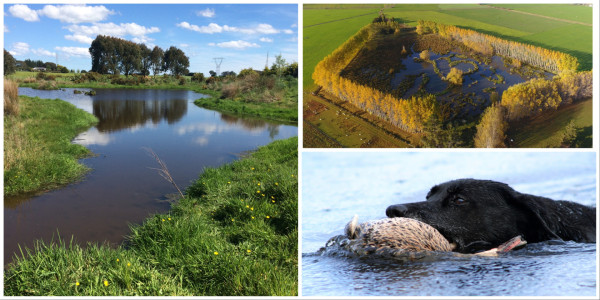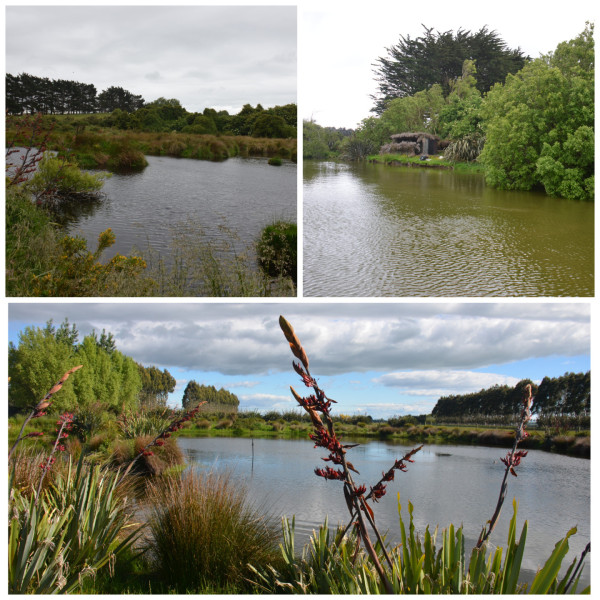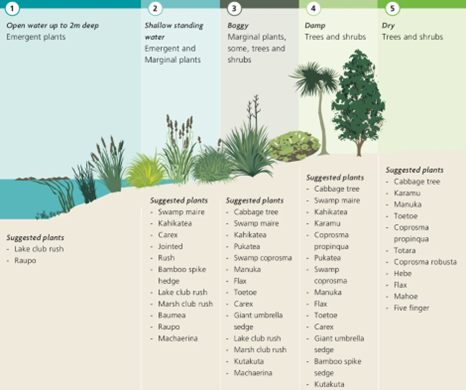Wetlands are great to look at, improve water quality and add biodiversity on farm. They are an asset to you, to wildlife and for recreation.
This information is designed to improve:
- the biodiversity of your wetland (pond) - from plants, to insects, fish and birds.
- the suitability of your pond as habitat for gamebirds.
- the ‘huntability’ of your pond, allowing you to maximise your hunting opportunities.
Every pond site is unique, so the information presented here is not prescriptive. It is up to you to take these principles and apply them as you see fit. Take the time to sketch out a rough plan on paper, and don’t be afraid to reflect and make changes where necessary.
While this information is written with Southland in mind, the concepts will be widely applicable.
Initial Considerations
- Waterfowl flight paths. From which direction do you mostly observe birds coming to your pond?
- Prevailing wind direction. Gamebirds land and take-off into the wind, so this determines how they will approach your pond and where they choose to land.
- What time of day do you observe waterfowl using your pond / when do you intend to hunt it. Trail cameras are a great tool for identifying when birds are on your pond.
- Where will waterfowl try to land and what is your shooting zone. This will be determined by the wind, trees, how you set your decoys and any other safety considerations.
- The environment – is it coastal or inland, windy or sheltered, wet or dry climate etc.
- Water level – is the pond consistent or does it rise and fall.
- If it is a constructed wetland, then it will have a dam wall and spillway that need to be identified.

Maimai
-
- Ensure you have a good view/outlook of the area, especially in the direction in which the birds are typically travelling from. If needed, cut some trees/branches back.
- Aim to be 20-30m from the gamebird landing zone. Any closer and the dense shot will ruin the meat, any further and your shot may be lacking impact.
- It is important you pattern your shotgun/ammunition/choke(s) at this range. This will give you greater confidence in calling your shot. Patterning sheets are available at no charge in all Fish and Game offices. Watch this for more info. Insert - https://www.youtube.com/watch?v=a9oWL220M30
- As a rule, for a large pond, the maimai should be on the water’s edge (or above the water), and for a small pond, it can be set back appropriately.
- Consider sunstrike. You don’t want to be looking directly into the sun as you will struggle to see the birds, and they will see you more easily. I.e., if you hunt in the evenings, don’t face your maimai into the sunset (west) etc. Given our Gamebird Season envelops the winter solstice/shortest day, the sunrise is more from the NE, and sunset in the NW, especially in the Deep South.
- You should be able to get to the maimai safely and ideally, unseen. Cover electric fences with insulating materials or construct access stiles.
- How many hunters (and onlookers) does your maimai need to hold?
- This is a topic in itself and there are many, and varied opinions. For some more info see here.
Decoy Lay Out
- Here is a very informative guide to setting out decoys. Note especially the ‘U’ and ‘J’ layout to direct birds to a landing zone, which in most cases will be set in front of the maimai. Link - https://www.youtube.com/watch?v=WZd4_AYQ58A
Shoreline Structure
- Variation is the goal here.
- Avoid steep sides and high banks. Aim for gently sloping margins to provide loafing areas and shallow edges for dabbling habitat.
- Irregular shaped ponds have a longer shoreline, and it’s these productive margins that are favoured by waterfowl.
- If the pond is shallow, then it might be easy to create islands. Leave these unplanted, so waterfowl have a 360° field of view which increases their feeling of security. Be aware that predators can swim though, so they only feel

Plantings
- Allow a generous fenced off margin. Aim for 1:1 with the wetland size. This will create loafing and feeding areas and will increase the number of birds using the site.
- Use plants to create shelter from the cold and prevailing S and SW winds.
- Don’t plant tall trees on the northside that’ll shade the sun.
- Establish vegetation overhanging the water, especially on the S and SW margins. This will provide cover and shelter, while still allowing the low winter sun to penetrate underneath. This can be done with weeping or golden willow. Avoid crack willow as it can take over your pond. Plant willow poles in late winter.
- As a rule, the bigger the pond, the taller the trees you can have, and vice versa - the smaller the pond, the lower the trees. Make it easy for birds to drop in and climb out of a pond with minimal energy consumption.
- Tracking birds in front of tall trees while hunting during low light is difficult. So, consider this when setting out your landing zone, maimai location and planting plan.
- Do not plant woody stemmed trees on the dam wall. Tree roots can create seepage lanes that will undermine the structure. Also, the wind will cause the tree to rock, putting further pressure on the structural integrity of the dam. Instead, plant low growing and shallow rooted plants on the dam. Think: various carex and tussock grasses, flax, toi toi etc.
- Allow for future pond maintenance. Ensure there is machine access to the dam and spillway, and to the pond edge to remove sediment build up if/when necessary.
This image is a very useful planting guide. It keeps it simple, while providing options for personal preference. The rule is, close to the pond keep it small, and away from the pond you can grow taller.

Source: NIWA. (2022). Constructed Wetland Practitioner Guide: Design and Performance Estimates. Retrieved from https://niwa.co.nz/sites/default/files/import/attachments/Constructed-Wetland-Practitioner-Guide.pdf
Southland Fish and Game propagate carex secta which we provide free to local hunters. Numbers dependent.
Pest Control
- Not often seen but always present. Cats, ferrets, stoats, weasels, rats, and hedgehogs are destructive predators and removing them will increase the survival rate of all valued species.
- Several bait stations and a couple of DOC200 or 250 traps is a minimalist, but worthwhile contribution. These don’t need to be placed near the pond and in fact, it’s better if they are not. It’s preferable to place traps in locations where it is easy to check and re-bait them. Try putting traps in hedgerows that are close to gateways for easy checking. Spring is the time to focus your trapping efforts.
- Feral cats. Southland Fish and Game has several live capture cat traps which we can lend out. Live capture traps are useful when you are trapping near houses as any domestic cats you capture can be freed.
- In most cases, a simple walk through with a knapsack once a year will be enough to keep on top of weeds.
- Willow – trim trees to ensure they don’t get too large and inspect the pond edge for any new, unwanted shoots.
- Pampas grass (not to be confused with the native toitoi). Remove all pampas grass as they create nest habitat for rats and mustelids underneath.
- For local advice on controlling all types of pests, see Environment Southland’s ‘Pest Hub’. Insert link https://pesthub.es.govt.nz/

We trust this has provided worthwhile advice. Again, the information is deliberately general in nature, allowing you to implement these principles to your unique site.
If you would like some site-specific advice, then please pop in or contact the Southland Fish and Game office.